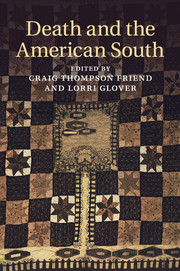Book contents
- Death and the American South
- Series page
- Death and the American South
- Copyright page
- Contents
- Illustrations
- Contributors
- Introduction: Death and the American South
- 1 Mutilated Bodies, Living Specters: Scalpings and Beheadings in the Early South
- 2 The Usable Death: Evangelicals, Anglicans, and the Politics of Dying in the Late-Colonial Lowcountry
- 3 When “History Becomes Fable Instead of Fact”: The Deaths and Resurrections of Virginia’s Leading Revolutionaries
- 4 American Mourning: Catastrophe, Public Grief, and the Making of Civic Identity in the Early National South
- 5 To Claim One’s Own: Death and the Body in the Daily Politics of Antebellum Slavery
- 6 Nativists and Strangers: Yellow Fever and Immigrant Mortality in Antebellum Charleston, South Carolina
- 7 “Cumberer of the Earth”: Suffering and Suicide among the Faithful in the Civil War South
- 8 The “Translation” of Lundy Harris: Interpreting Death out of the Confusion of Sexuality, Violence, and Religion in the New South
- 9 “He’s Only Away”: Condolence Literature and the Emergence of a Modern South
- 10 “A Monument to Judge Lynch”: Racial Violence, Symbolic Death, and Black Resistance in Jim Crow Mississippi
- 11 Reframing the Indian Dead: Removal-Era Cherokee Graves and the Changing Landscape of Southern Memory
- Index
1 - Mutilated Bodies, Living Specters: Scalpings and Beheadings in the Early South
Published online by Cambridge University Press: 05 November 2014
- Death and the American South
- Series page
- Death and the American South
- Copyright page
- Contents
- Illustrations
- Contributors
- Introduction: Death and the American South
- 1 Mutilated Bodies, Living Specters: Scalpings and Beheadings in the Early South
- 2 The Usable Death: Evangelicals, Anglicans, and the Politics of Dying in the Late-Colonial Lowcountry
- 3 When “History Becomes Fable Instead of Fact”: The Deaths and Resurrections of Virginia’s Leading Revolutionaries
- 4 American Mourning: Catastrophe, Public Grief, and the Making of Civic Identity in the Early National South
- 5 To Claim One’s Own: Death and the Body in the Daily Politics of Antebellum Slavery
- 6 Nativists and Strangers: Yellow Fever and Immigrant Mortality in Antebellum Charleston, South Carolina
- 7 “Cumberer of the Earth”: Suffering and Suicide among the Faithful in the Civil War South
- 8 The “Translation” of Lundy Harris: Interpreting Death out of the Confusion of Sexuality, Violence, and Religion in the New South
- 9 “He’s Only Away”: Condolence Literature and the Emergence of a Modern South
- 10 “A Monument to Judge Lynch”: Racial Violence, Symbolic Death, and Black Resistance in Jim Crow Mississippi
- 11 Reframing the Indian Dead: Removal-Era Cherokee Graves and the Changing Landscape of Southern Memory
- Index
Summary
- Type
- Chapter
- Information
- Death and the American South , pp. 15 - 35Publisher: Cambridge University PressPrint publication year: 2014



